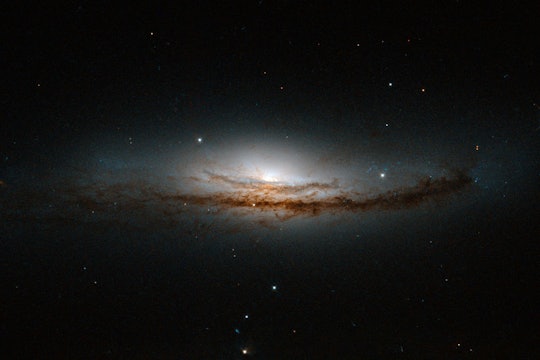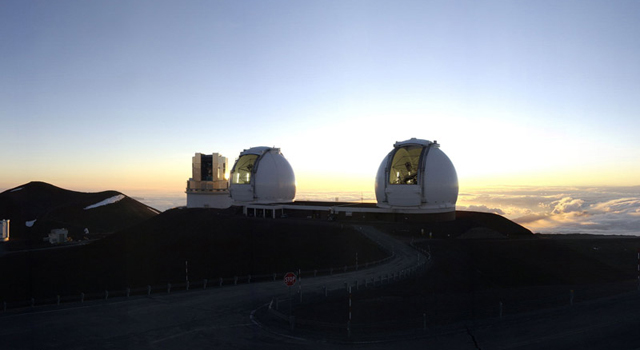
Galaxies are eating each other and the Milky Way might be next
Astronomers see a trail of destruction in the patterns of Andromeda's stars.
There is a lot of space in space. With our current technology, it may seem like the stars are untouchable, but our concept of space changes when you go from looking at objects the size of stars and planets to objects as large as galaxies. Our own galaxy, the Milky Way, is a massive conglomeration of hundreds of billions of stars that’s a hundred thousand light-years across and 2.5 million light-years away from another galaxy, Andromeda. Both galaxies live in a group with a third, similarly sized galaxy and a whole slew of much smaller galaxies.
When astronomers look out into the universe, we see that galaxies commonly live in these types of groups — gravitationally bound to each other in the slowest do-si-do ever performed. But to galaxies, the millions of light years between them are trivial compared to their sizes. If you shrank our galaxy down to the size of a person six feet tall, Andromeda would only be about 150 feet away. So, although stars and planets rarely run into each other, galaxies do all the time. It's hard for astronomers to see this in real-time because the immense distances mean we only get a snapshot of the added light from all the stars. The faint debris from these galactic hoe-downs is rarely detectable with even our most powerful telescopes.

It would look like this if galaxies had feet. And hands.
Lomax Collection, Library of Congress
Andromeda is so close, though, that astronomers can measure individual stars' age and composition by looking at spectra. Just as light from the Sun can be spread out into separate colors by raindrops, the light from other stars can be spread out into their own rainbows. Each element in a star absorbs specific colors of light, leaving a fingerprint of missing colors in the spectrum.
Stars' spectra also provide an upper limit to their ages. Stars that are five or more times as massive as the Sun have to be much hotter in order to exist. They live much shorter lives than the Sun as they burn through their material. Higher temperatures also make it more difficult for atoms to interact with light, so fewer colors are missing in the spectrum. If you look in a given area of a galaxy and see these hot stars, then you can conclude the stars there were created tens or hundreds of millions of years ago. But if you look in a region and see only cooler stars, that means they've been around for a few billion years; all the younger, hotter stars have had time to live out their lives and disappear.
Armed with this information, astronomers turned to the stars in Andromeda. Most of Andromeda lies in a flat disk surrounding a central bulge of stars, like a sunny-side-up egg. There are, however, a smattering of stars surrounding the main structure. In this outer region, most stars have very different spectra than the stars in the main structure...almost as if they came from somewhere else.
A destructive past
Researchers at the University of Michigan set out to determine what conditions could create the structures surrounding Andromeda, and published their findings in Nature Astronomy earlier this year. Because we cannot rewind the clock on the universe, the best way to test what happened in the past is to use computer simulations. These models treat the stars and gas within galaxies as fluids and provide initial conditions that reflect what we see happen to fluids under known physical constraints, such as gravity.
Richard D'Souza and Eric Bell identified galaxies that had the same number of stars remaining in their outer regions as presently seen in Andromeda. Once they identified these analogs, they rewound their simulation to see what type of galaxy could create something like Andromeda. They found that the most common way for the simulated galaxies to end up with enough stars in their outer regions is through an interaction with another large galaxy. In the simulations, the two galaxies don't tear each other apart and settle down into a single galaxy. Instead, there's a clear winner: the Andromeda-like galaxy slowly unravels the other galaxy like a ball of yarn, leaving a distinct trail of stars.

Looking...looking...looking
NASA JPL
So, what galaxy did Andromeda attack? The researchers found the remnants of a large galaxy nearby: M32, a dense sphere of stars nestled close to Andromeda. Its stars have the same chemical makeup and age as the stars in Andromeda’s outer regions. Combining these observations with their simulations, researchers came up with a hypothetical scenario that can be tested with future data.
Around five billion years ago, as our solar system started to form, Andromeda began unraveling M32. The gas in M32 got disrupted and compressed, causing a burst of star birth as it unwound. This explains the unique atoms of the stars in the outer regions of Andromeda and their ages. After 3 billion years passed, the star birth stopped, which is why we don’t see any young, hot stars in M32 or surrounding Andromeda.
Is the Milky Way next?
Our own galaxy is currently on a collision course with Andromeda. In 4 billion years, our galaxy could suffer the same fate as M32, but this depends on a lot of factors. The Milky Way is 2.5 times more massive than M32 was when it tangled with Andromeda and it's expected to make new stars over time, getting even larger. The rotation and trajectory of our galaxy will ultimately determine whether Andromeda and the Milky Way collide head-on or if our galaxy is slowly unwound.
We have time to make these predictions. In the meantime, astronomers can continue to use Andromeda and the Milky Way to better understand how cannibalizing other galaxies influences both the overall structure of a galaxy and the properties of their stars.
